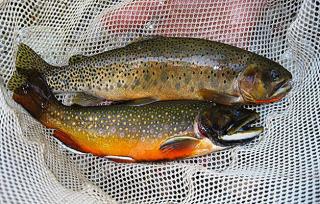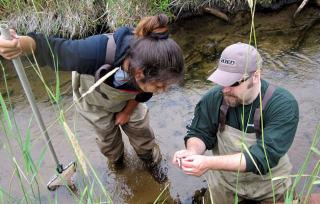Fisheries - Applying Science
- Find Research Products
-
Treesearch is an online system for sharing free, full text publications by Research and Development scientists in the US Forest Service. Nearly 50,000 scientific publications are available through Treesearch. Thousands of these publications address topics relevant to fish and aquatic conservation, including stream temperature, riparian grazing, aquatic invasive species, fish population genetics, and habitat quality and connectivity. Search now to learn more about these and other topics.
- Meet Our Scientists
-
Forest Service scientists produce unbiased research and tools to inform policy and management affecting fish and other aquatic species, and their habitats. These scientists work in disciplines such as fish biology, genetics, and hydrology to conduct basic and applied research on aquatic species and ecosystems. Their science helps improve strategies for meeting growing demands for water, energy, and other forest-based commodities while ensuring the sustainability and diversity of aquatic species. Get to know a few of these dedicated researchers in the videos below.
Dr. Dan Isaak (Boise, ID) – Dr. Isaak provides a brief overview of his NorWest Stream Temperature Project, a crowd-sourced stream temperature database for the western United States to which over 100 resource agencies have contributed.
Dr. Kellie Carim (Missoula, MT) – Dr. Carim of the USFS National Genomics Center for Wildlife and Fish Conservation demonstrates sampling for environmental DNA (eDNA) in a stream and explains how this process allows biologists to collect the DNA found in anything a fish sloughs off, from skin cells to feces to slime, and use that DNA to detect the presence or absence of various species.
Russ Thurow (Boise, ID) – Mr. Thurow talks about his work investigating wild Chinook salmon populations in the Middle Fork to the Salmon River. The Middle Fork is located in a wilderness area where natural processes are allowed to function relatively unimpeded on the landscape, offering important insights about riverine processes and fish habitat formation.
Dr. Rich MacKenzie (Hilo, HI) - The life cycle of native Hawaiian shrimp depends heavily on stream flow to carry them out to sea. A warmer, drier climate means less water in the streams, which could jeopardize their viability. In this video, PSW research ecologist Dr. Rich MacKenzie talks about his research on the shrimp and what they tell us about the surrounding ecosystem.
Dr. Gordon Reeves (Corvallis, OR) – Dr. Reeves explains his climate change research in the Copper River Delta in the Chugach National Forest near Cordova, Alaska. He is investigating how changes in the timing of aquatic insect emergence affect migrating birds.
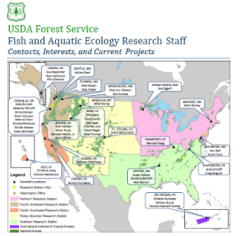
Contact information and research interests for all of the Forest Service research fish biologists and aquatic ecologists is available at 'Contact Us - Our Team'. Coming soon is our downloadable Aquatic Scientist Directory.
- Tools that Inform Conservation
-
Forest Service scientists have a strong track record of developing and applying innovative methods for studying fishes and aquatic ecosystems at all geographic scales and over long periods of time. Their work has produced crucial insights into the importance of watershed integrity, natural disturbance regimes, habitat complexity and connectivity, and gene flow for the long-term viability of aquatic species. In recent years, Forest Service scientists have created user-friendly tools to organize, analyze, and share information about fish habitat and associated watershed characteristics to improve the cost-effectiveness of investments in aquatic stewardship.
Highlighted Tools
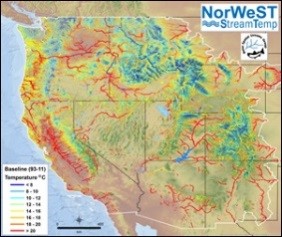
NorWeST Western Stream Temperature Database – This project makes freely available stream temperature data and geospatial model outputs from a regional temperature model for the western U.S. The database was compiled from records collected by hundreds of biologists and hydrologists working for more than 100 resource agencies and contains more than 200,000,000 hourly temperature recordings at more than 20,000 unique stream sites. This data informs the selection of conservation investments in locations that are likely to sustain native trout species into the future.
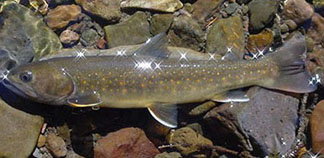
Range-wide Bull Trout Distribution Assessment – Making use of emerging
environmental DNA (eDNA) sampling techniques, Forest Service biologists and collaborators are surveying and mapping the distribution of the threatened Bull Trout throughout its entire historic range. This project demonstrates the value of rapid, robust, and cost-effective eDNA sampling for providing insights about the distribution of aquatic species that were not previously available.
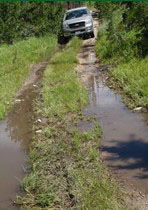
The Geomorphic Road Analysis and Inventory Package (GRAIP) – Excess
sediment can have serious negative effects on water quality and fish habitat in streams. Forest Service researchers developed GRAIP to help land managers learn about and mitigate the impacts of road systems on erosion and sediment delivery to streams.
Research Groups
Forest Service scientists are organized into research programs administered by research stations that are distributed throughout the United States. You can learn about the scientists in each group and about their current projects by visiting each program’s website.
Northern Research Station – Center for Research on Ecosystem Change
Southern Research Station – Center for Bottomland Hardwoods Research
Southern Research Station – Center for Aquatic Technology Transfer
Rocky Mountain Research Station – Air, Water, and Aquatic Environments Program
Pacific Northwest Research Station – Land and Watershed Management Program
Pacific Southwest Research Station – Conservation of Biodiversity Program

